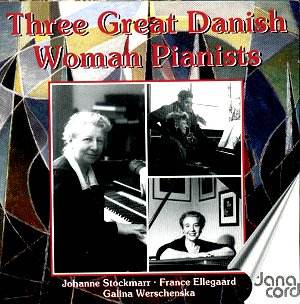The title of this disc is a bit of a mouthful
and the geographical truth of the matter is that of the three
only Johanne Stockmarr was Danish-born. France Ellegaard
hailed from Paris and Galina Werschenska came from a long established
patrician St Petersburg family. Though there was concert-giving
overlap between them – they were all active to some degree domestically
between 1929-44 – I suspect that the big name here, Stockmarr,
will command the majority of interest. She was an exceptional
artist and had been nurtured in an intensely musical environment.
One of her earliest teachers was the Moravian cellist and composer
Franz Neruda, long since a Danish resident, whose sister Wilhelmine
was later better known as Lady Hallé and with whom the
young Johanna was to tour. A Royal Court pianist and a friend
and noted exponent of Grieg she was highly popular in Britain
– where she made her first discs – and her long career lasted
up until death in 1944. The bulk of her discs here date from two
years before this, though there is a scattering of 1926-30 material.
One of the most extended is the Mozart K282 and here we can immediately
appreciate a number of things; the concentrated seriousness of
her playing in the Adagio opening, the spaciousness engendered
through subtlety of rubato and the depth of her tone. There is
a mellowness and articulacy to the Menuetto as well that is attractive
and that reveals her expressive nuance. Les Adieux finds
her once more full of depth and superfine right hand tracery the
opening movement. Elsewhere she is a little stretched by some
physical and technical demands but Le Retour triumphs in spite
of them. There is a natural aristocracy of phrasing in Chopin’s
Nocturne in E flat – nothing’s over accented – and there is real
dash and sweeping splendour to the Dohnányi Rhapsody.
France Ellegaard recorded her selection
of eight items between 1943 and 1953. She was popular in Denmark
and proves herself a pianist in the boldest of French traditions.
There are some delicious filigree voicings and effects in the
Chopin Waltz in C sharp minor; pedalling is light albeit with
slightly too much rubato; intensity is generated through a slow-ish
tempo. Ideally if she’d played in tempo her lightness would have
been even more effective but she proves she was, at her best,
an inventive, imaginative player who constantly changes colour.
Above all she’s frequently very stylish. Elsewhere she can be
rather more erratic – the Liszt Hungarian Rhapsody gets a rather
on/off performance for example and Liebestraum is not so good
– I don’t think he was her forte. Her Franck Prelude, Chorale
and Fugue is a little pallid in places and cool as well.
The final member of this conjoined trio is Galina
Werschenska. After her move to Denmark she received plenty
of advice from Stockmarr, Henriques and Anton Svendsen. She had
a piano trio and formed a duo with the fine cellist Louis Jensen
but soloistic ambitions took the upper hand. Though her career
rather petered out in the 1950s – her husband was killed in a
car crash and she later developed a disabling neuritis – she continued
playing on a much more limited scale. The bulk of her discs derive
from 1946 sessions. Her Chopin Sonata lacks a little dramatic
realization but other things go very well indeed. Her Hummel is
pertly attractive in the finest tradition, her Beethoven Ecossaises
splendid. When it comes to the leonine Brahms’ Rhapsody in G minor
I find that she does rather lose out on the potential for implicit
drama though it’s otherwise convincing on its own terms. The series
of Preludes clearly show her priorities – Scriabin, Prokofiev,
Rachmaninov - the music of her Russian inheritance. The control,
the evenness and the wit all mark her out as a notable exponent
of this repertoire, even if the Rachmaninov Prelude in C is rather
limited in terms of actual projection.
The documentation here is really excellent –
I owe much to the biographical details – and the two discs are
a most worthwhile conspectus of these three very varied women,
whose geographical origins and stylistic imperatives were themselves
disparate. I’m sure the curious listener will derive great pleasure
from this laudable set.
Jonathan Woolf


